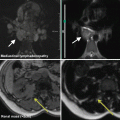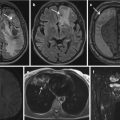Fig. 1
An abdominal aortic aneurysm (yellow arrows) with intraluminal thrombotic material (red arrow)

Fig. 2
Same patient as in Fig. 1. Color Doppler shows the blood flow in the abdominal aortic aneurysm (yellow arrows), with no detectable blood flow in the thrombotic areas of the aneurysm (red arrows)
3 Hemangiomas and Liver Cysts
3.1 Hemangiomas
Hemangiomas of the liver are one of the most common incidental finding found during standard examinations of the liver. Although hemangiomas can occur at every site of the human body, about 30 % of all hemangiomas can be found inside the liver. The incidence rate is about 0.4–20 % (Bajenaru et al. 2015). Hemangiomas can be found four to five times more often in women as in men, which might be explained by estrogen as a stimulus (Kleinman et al. 2007; Dockerty et al. 1956). Hemangiomas are benign tumors which usually do not show a malignancy and do normally not cause any signs or symptoms (Bajenaru et al. 2015). Sonographic features include a hyperechoic lesion with sharp margins, posterior acoustic enhancement, and no visible perfusion in color Doppler due to the slow perfusion of the hemangiomas. Mostly, they are solitary and located subcapsular in the right lobe of the liver, although multilocular hemangiomas are possible, and show various sizes from a few millimeters up to 40 cm (Bajenaru et al. 2015; Koszka et al. 2010; Nakanuma 1995). Ultrasound surveillance should be performed on a regular basis, because about 10 % of all hemangiomas show a growth in size over time and bigger hemangiomas might cause symptoms, e.g., compression of adjacent structures (Bajenaru et al. 2015). CEUS can be used to verify the diagnosis, as hemangiomas show a specific contrast enhancement pattern after contrast agent injection with a peripheral nodular contrast enhancement and consecutive centripetal filling (Bajenaru et al. 2015). Normal hemangiomas do not require any treatment as long as they do not cause secondary problems. Ultrasound surveillance should also been carried out during pregnancy or in women using contraceptives, as estrogen can induce a size growth. Surgical therapy is only needed in cases of abnormal rapid size growth or risk for secondary problems and includes enucleation, segmental resection, or lobectomy (Figs. 3, 4, and 5) (Bajenaru et al. 2015).




Fig. 3
Classical hemangioma in B-mode ultrasound. A solitary hyperechoic lesion can be seen with sharp margins, subcapsular located in the right liver lobe

Fig. 4
Asymmetrically shaped hyperechoic lesion with sharp margins suggestive of a hemangioma, although not fulfilling the typical criteria for a hemangioma. An additional contrast-enhanced ultrasound was recommended for further diagnosis

Fig. 5
Same patient as in Fig. 4. Contrast-enhanced ultrasound confirms the finding of a hemangioma with a classical nodular contrast enhancement pattern of the lesion
3.2 Liver Cysts
Liver cysts are a common incidental findings found during standard examinations of the liver. Liver cysts are benign fluid-filled cysts inside the liver parenchyma and are not considered as malignant. Normally they are anechoic and round to ovally shaped and show a characteristic posterior acoustic enhancement in B-mode ultrasound. They occur in about 2.5 % of the population with an age-dependent increasing incidence (Gaines and Sampson 1989). Comparable to the hemangiomas described earlier, they occur more commonly in women and are more often found solitary in the right liver lobe, although multiple liver cysts can also be found (Gaines and Sampson 1989). The etiology of most liver cysts is not known; they can occur at birth or can occur later on. Normal liver cysts do not require any further treatment as long as they do not cause any secondary problems (Figs. 6, 7, 8, and 9).





Fig. 6
A simple liver cyst (yellow arrow) of the right liver lobe in native B-mode ultrasound. The cyst shows the classical findings in B-mode ultrasound with a round shape, sharp margins, and posterior acoustic enhancement

Fig. 7
Same patient as in Fig. 6. Color Doppler confirms the diagnosis of the native B-mode ultrasound with no detectable blood flow inside the cyst (yellow arrow)

Fig. 8
Liver cyst (yellow arrows) with slightly lobulated walls still showing characteristics of a simple benign liver cyst, being anechoic in native B-mode ultrasound and characteristic posterior acoustic enhancement

Fig. 9
Same patient as in Fig. 8. Color Doppler confirms the diagnosis of the native B-mode ultrasound with no detectable blood flow inside the cyst (yellow arrows)
4 Cholelithiasis
Gallstones in the gallbladder are one of the most common findings in the ultrasound examination of the gallbladder in adolescents. They are mostly incidentally found in asymptomatic patients and do not require any treatment in asymptomatic patients regardless of size and number (Acalovschi et al. 2003). About 10–15 % of all adolescents are considered to have gallstones and they can be found about two times more often in women compared to men (Shaffer 2006). Common predisposing risk factors include, for example, genetic risk factors, obesity, hypercholesterolemia, pregnancy, and female sex (Shaffer 2006; Buch et al. 2007). About 25 % of all gallstones get symptomatic with a typical abdominal pain in the upper-right side. Typical sonographic features include an echoic focus inside the gallbladder that cast a dorsal acoustic shadow. The most common complication of gallstones is the obstruction of the common bile duct, which might result in acute cholecystitis, ascending cholangitis, or pancreatitis. Therapeutical options include cholecystectomy, endoscopic retrograde cholangiopancreatography (ERCP), or extracorporeal shock wave lithotripsy (Figs. 10 and 11).


Fig. 10
Multiple hyperechoic foci (yellow arrows) inside the gallbladder that cast an acoustic dorsal shadow in line with the classical native B-mode findings of gallstones








